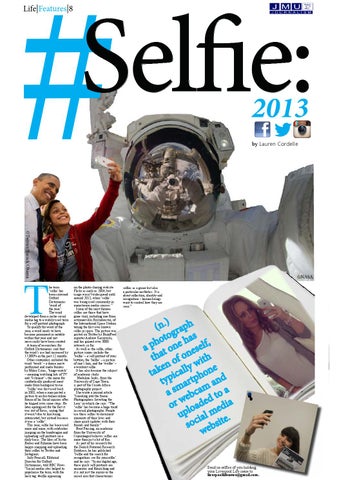# Life|Features|8
Selfie: 2013 by Lauren Cordelle
©Twitter/Barack Obama
T
he term ‘selfie’ has been crowned Oxford Dictionaries ‘word of the year’. The word developed from a niche social media tag to a widely used term for a self-portrait photograph. To qualify for word of the year, a word needs to have become prominent or notable within that year and not necessarily have been created. A team of researchers for Oxford Dictionaries said that the word’s use had increased by 17,000% in the past 12 months. Other contenders included the word ‘twerk’ – a dance move performed and made famous by Miley Cyrus, ‘binge-watch’ – meaning watching lots of TV and ‘Schmeat’ – the name for synthetically produced meat made from biological tissue. ‘Selfie’ was first used back in 2002, when a man posted a picture to an Australian online forum of his facial injuries after he tripped over some steps. He later apologised for the fact it was out of focus, saying that it wasn’t due to him being intoxicated, but instead because it was a ‘selfie’. This year, selfie has been used more and more, with celebrities jumping on the bandwagon and uploading self-portraits on a daily basis. The likes of Justin Bieber and Rihanna have been happy-snapping and uploading their selfies to Twitter and Instagram. Judy Pearsall, Editorial Director for Oxford Dictionaries, told BBC News: “Social media sites helped to popularise the term, with the hash tag: #selfie appearing
©NASA on the photo-sharing website Flickr as early as 2004, but usage wasn’t widespread until around 2012, when ‘selfie’ was being used commonly in mainstream media sources.” Some of the most famous selfies are those that have gone viral, including one from astronaut Aki Hoshideustin, of the International Space Station taking the first ever known selfie in space. The picture was posted on Twitter by BuzzFeed reporter Andrew Kaczynski, and has gained over 3000 retweets so far. As well as the selfie, other picture crazes include the ‘belfie’ – a self-portrait of your bottom, the ‘helfie’ – a picture of one’s hair, and the ‘welfie’ – a workout selfie. It has also become the subject of academic study. Madeline Jenks, from the University of Cape Town, is part of the Curate Africa photography project. She wrote a journal article ‘Sneaking into the frame: Photographers Inverting the Lens’ in which she says: “The ‘selfie’ has become a huge trend in casual photography. People use these selfies to document moments of their lives and share quick updates with their friends and family.” Bent Fausing, an academic from the University of Copenhagen believes selfies are more than just a bit of fun. As part of his research for the Danish National Research Database, he has published ‘Selfie and the search for recognition: see for yourselfie’ and he says: “In our digital age, these quick self-portraits are numerous and flourishing and it is not just the mirror or the raised arm that characterizes
selfies as a genre but also a particular aesthetics. It is about reflection, identity and recognition – human beings want to control how they are seen.”
) (n. raph g as o t ho ne h elf, p a o nes t a th of o ith n lly w e e k ta pica phon d n ty art a a sm ebcam to a w ded ia r o loa d e up ial m e. soc ebsit w
Send us selfies of you holding your Liverpool Life issue to liverpoollifenews@gmail.com.
